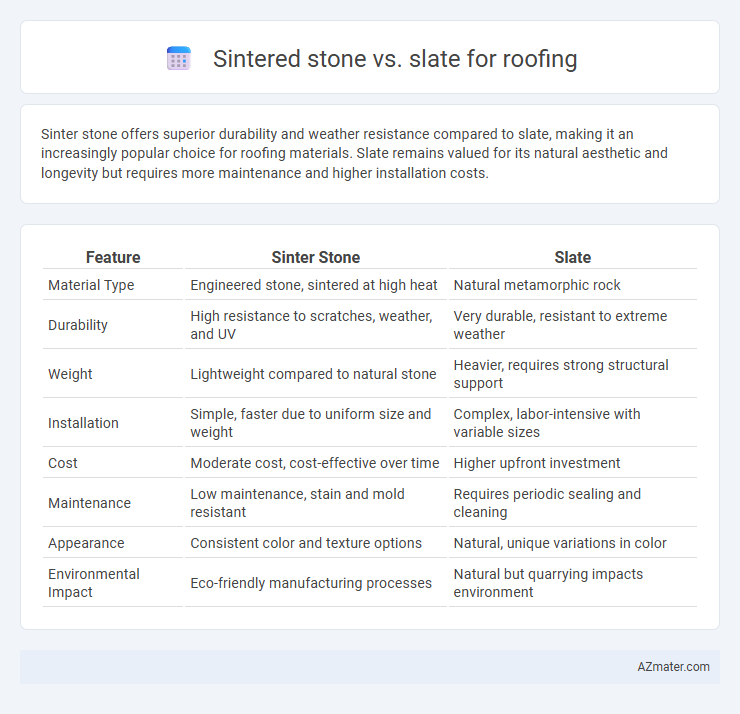Sinter stone offers superior durability and weather resistance compared to slate, making it an increasingly popular choice for roofing materials. Slate remains valued for its natural aesthetic and longevity but requires more maintenance and higher installation costs.
Table of Comparison
| Feature | Sinter Stone | Slate |
|---|---|---|
| Material Type | Engineered stone, sintered at high heat | Natural metamorphic rock |
| Durability | High resistance to scratches, weather, and UV | Very durable, resistant to extreme weather |
| Weight | Lightweight compared to natural stone | Heavier, requires strong structural support |
| Installation | Simple, faster due to uniform size and weight | Complex, labor-intensive with variable sizes |
| Cost | Moderate cost, cost-effective over time | Higher upfront investment |
| Maintenance | Low maintenance, stain and mold resistant | Requires periodic sealing and cleaning |
| Appearance | Consistent color and texture options | Natural, unique variations in color |
| Environmental Impact | Eco-friendly manufacturing processes | Natural but quarrying impacts environment |
Introduction to Sinter Stone and Slate Roofing
Sinter stone roofing consists of natural materials fused under intense heat, creating a durable, lightweight, and weather-resistant surface ideal for modern architecture. Slate roofing, formed from natural metamorphic rock, offers exceptional longevity, fire resistance, and a classic aesthetic favored in traditional and historic buildings. Both roofing options provide distinct benefits in durability and visual appeal, with sinter stone emphasizing innovative material science and slate highlighting timeless natural beauty.
Material Composition: Sinter Stone vs Slate
Sinter stone features a composite material made from natural minerals fused under high temperatures, resulting in a dense, durable surface resistant to weathering and stains. Slate is a natural metamorphic rock composed primarily of quartz, mica, and chlorite, offering excellent longevity and a distinctive layered texture. The man-made sinter stone allows for uniform thickness and customizable colors, whereas slate's natural formation leads to variability in thickness and color, often valued for its authentic aesthetic.
Durability and Lifespan Comparison
Sinter stone roofing offers superior durability due to its high resistance to UV radiation, extreme weather conditions, and chemical corrosion, providing a lifespan of up to 50 years with minimal maintenance. Slate, known for its natural formation and dense composition, boasts an exceptional lifespan exceeding 75 years and outstanding resistance to fire, water, and temperature fluctuations. While both materials exhibit long-lasting performance, slate's natural toughness often surpasses sinter stone in durability, making it a preferred choice for historic and premium roofing applications.
Weather Resistance and Performance
Sinter stone offers superior weather resistance compared to slate, with enhanced durability against extreme temperatures, frost, and UV radiation, making it ideal for harsh climates. Slate provides excellent natural water resistance and longevity, but its porous nature can lead to weathering over time, requiring regular maintenance. Performance-wise, sinter stone's engineered composition delivers consistent strength and low absorption rates, while slate's traditional aesthetic and natural variability appeal to historic preservation with proven resilience.
Aesthetic Appeal and Design Options
Sinter stone offers a sleek, contemporary look with a smooth, consistent surface that enhances modern architectural designs, while slate provides a classic, natural texture with unique color variations that complement traditional and rustic styles. The wide range of sinter stone colors and finishes allows for greater customization, whereas slate's inherent variation ensures each roof is one-of-a-kind with rich, earthy tones. Both materials are durable and sustainable, but sinter stone's precision manufacturing supports more uniform design executions compared to slate's handcrafted aesthetic.
Environmental Impact and Sustainability
Sinter stone roofing offers enhanced environmental benefits due to its sustainable manufacturing process, utilizing natural raw materials and lower energy consumption compared to slate quarrying. Slate roofing, while durable and long-lasting, involves extensive mining that disrupts natural habitats and generates higher carbon emissions. The renewable nature and recyclability of sinter stone contribute to reduced environmental footprints, positioning it as a more sustainable roofing material in green construction.
Installation Process and Complexity
Sinter stone roofing requires specialized cutting and precise handling due to its dense and brittle composition, making the installation process more complex compared to slate. Slate roofing, known for its natural cleavage and flexibility, allows easier shaping and fitting, which reduces installation time and labor intensity. Both materials demand skilled craftsmen, but sinter stone's rigidity necessitates advanced tools and techniques to prevent cracking during installation.
Maintenance Requirements Over Time
Sintered stone roofing demands minimal maintenance due to its high durability, resistance to weathering, and non-porous surface that prevents moss and algae growth. Slate roofs require regular inspections and occasional repairs to address potential slate cracking, delamination, or fastener corrosion over time. Overall, sintered stone offers a more maintenance-efficient roofing solution compared to the traditional upkeep-intensive slate.
Cost Analysis: Sinter Stone vs Slate Roofing
Sinter stone roofing typically offers a lower initial cost compared to natural slate, making it an economical choice for budget-conscious projects. Slate roofing, while more expensive upfront due to quarrying and labor-intensive installation, often provides superior longevity and durability, potentially reducing long-term maintenance expenses. Evaluating total lifecycle costs reveals that sinter stone balances affordability with aesthetic appeal, whereas slate demands higher investment but yields greater resale value and sustainability benefits.
Choosing the Best Roofing Option for Your Needs
Sinter stone roofing offers exceptional durability and vibrant color options, making it ideal for modern architectural designs demanding long-lasting materials. Slate roofing provides a classic, natural aesthetic with excellent fire resistance and longevity, often lasting over a century with proper maintenance. Evaluating factors such as climate resilience, maintenance costs, aesthetic preferences, and budget will help determine whether sinter stone's contemporary benefits or slate's traditional virtues better suit your roofing needs.

Infographic: Sinter stone vs Slate for Roofing
 azmater.com
azmater.com